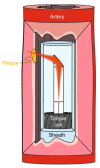Towards OCT-Guided Endoscopic Laser Surgery-A Review
- PMID: 36832167
- PMCID: PMC9955820
- DOI: 10.3390/diagnostics13040677
Towards OCT-Guided Endoscopic Laser Surgery-A Review
Abstract
Optical Coherence Tomography (OCT) is an optical imaging technology occupying a unique position in the resolution vs. imaging depth spectrum. It is already well established in the field of ophthalmology, and its application in other fields of medicine is growing. This is motivated by the fact that OCT is a real-time sensing technology with high sensitivity to precancerous lesions in epithelial tissues, which can be exploited to provide valuable information to clinicians. In the prospective case of OCT-guided endoscopic laser surgery, these real-time data will be used to assist surgeons in challenging endoscopic procedures in which high-power lasers are used to eradicate diseases. The combination of OCT and laser is expected to enhance the detection of tumors, the identification of tumor margins, and ensure total disease eradication while avoiding damage to healthy tissue and critical anatomical structures. Therefore, OCT-guided endoscopic laser surgery is an important nascent research area. This paper aims to contribute to this field with a comprehensive review of state-of-the-art technologies that may be exploited as the building blocks for achieving such a system. The paper begins with a review of the principles and technical details of endoscopic OCT, highlighting challenges and proposed solutions. Then, once the state of the art of the base imaging technology is outlined, the new OCT-guided endoscopic laser surgery frontier is reviewed. Finally, the paper concludes with a discussion on the constraints, benefits and open challenges associated with this new type of surgical technology.
Keywords: OCT; endoscopy; laser surgery; theranostics systems.
Conflict of interest statement
The authors declare no conflict of interest.
Figures










References
-
- Sun J., Xie H. MEMS-Based Endoscopic Optical Coherence Tomography. Int. J. Opt. 2011;2011:825629. doi: 10.1155/2011/825629. - DOI
-
- Aumann S., Donner S., Fischer J., Müller F. Optical Coherence Tomography (OCT): Principle and Technical Realization. In: Bille J.F., editor. High Resolution Imaging in Microscopy and Ophthalmology: New Frontiers in Biomedical Optics. Springer International Publishing; Cham, Switzerland: 2019. pp. 59–85. - DOI - PubMed
Publication types
LinkOut - more resources
Full Text Sources

